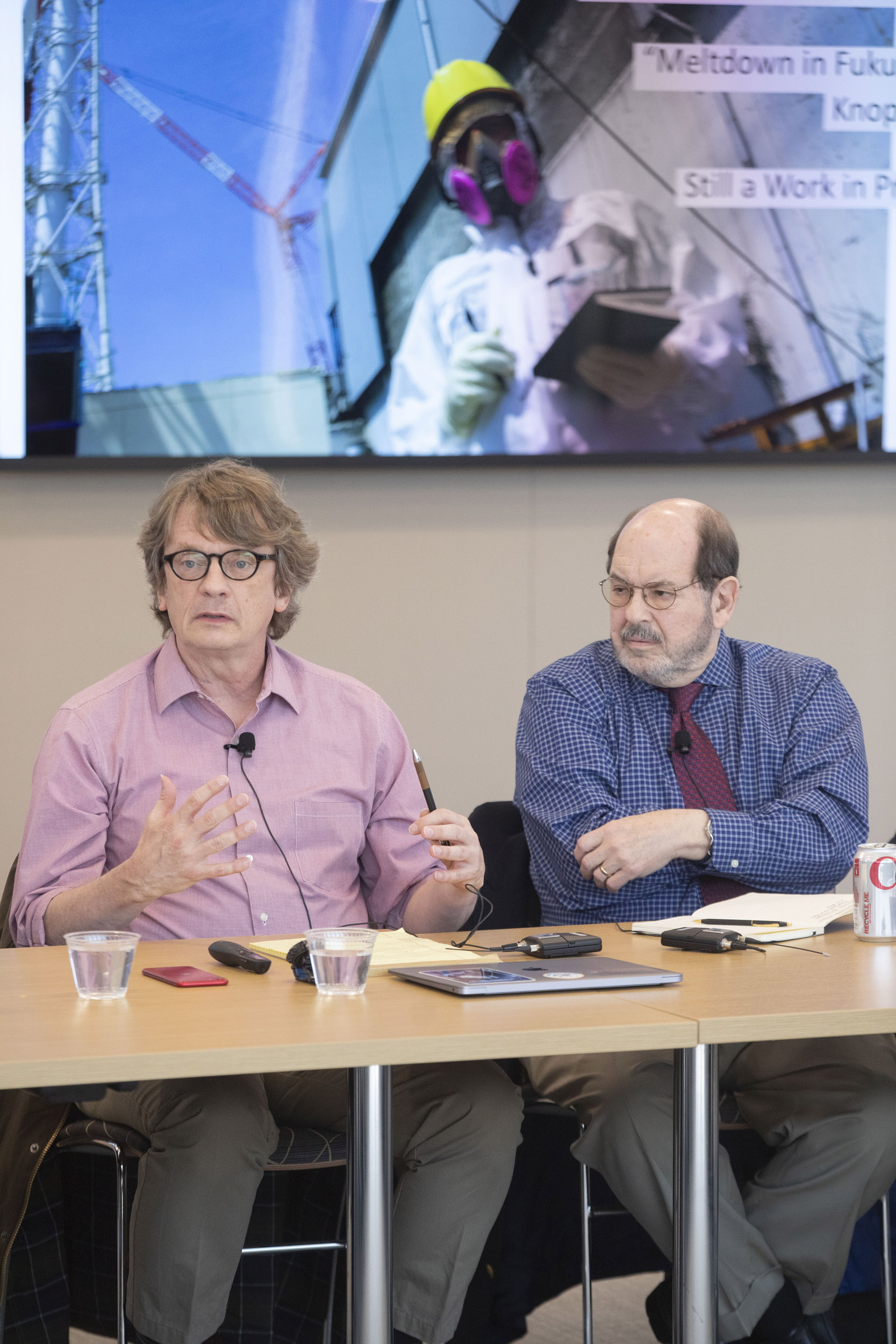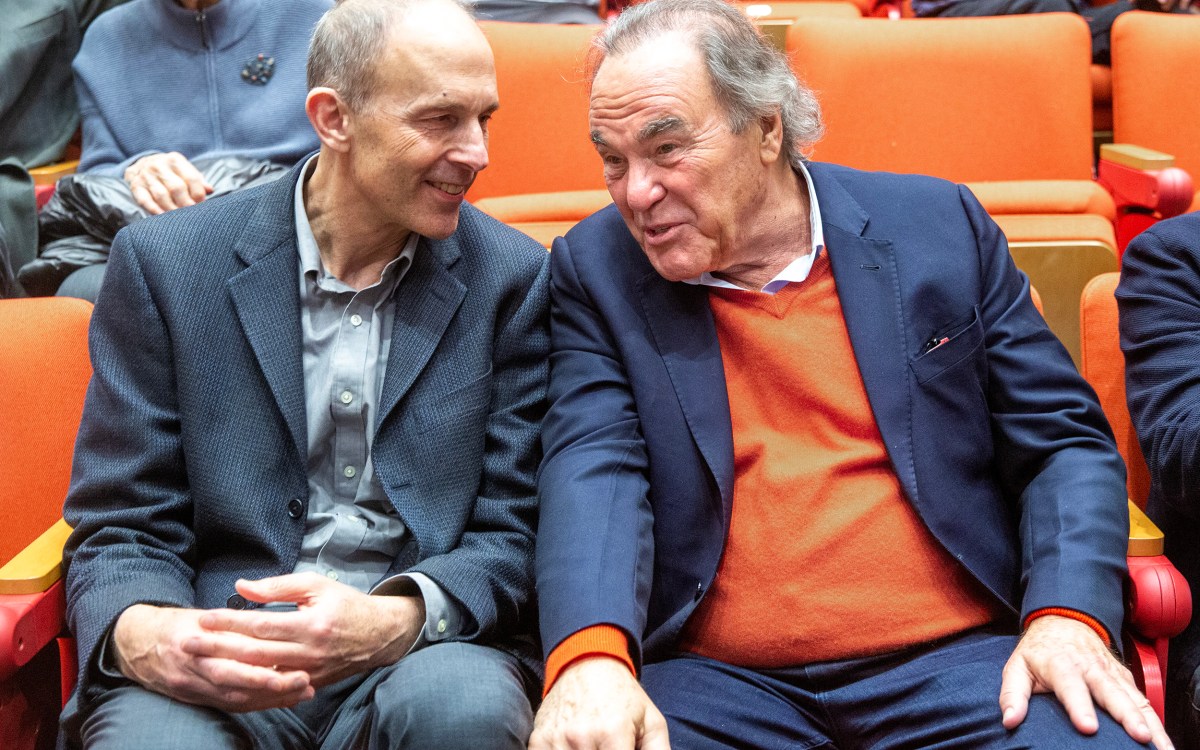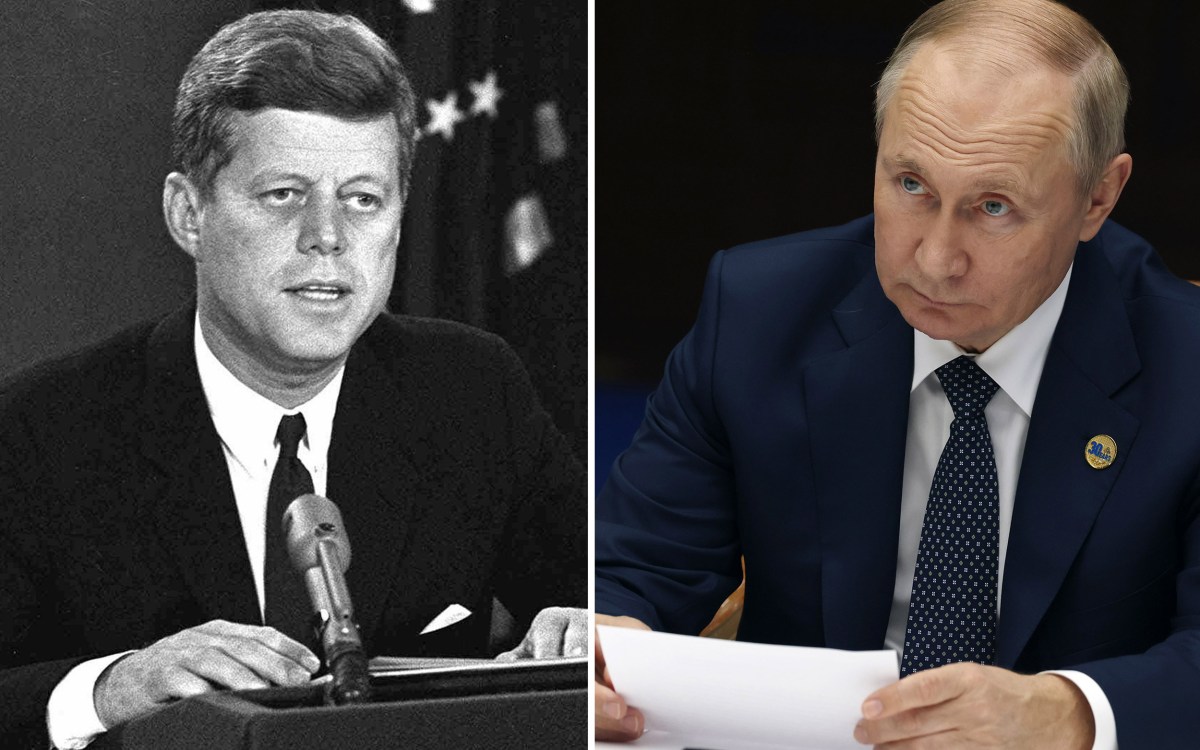
In 2011, journalist Martin Fackler (left) arrived in Japan one day after a massive earthquake set off a nuclear meltdown at the Fukushima Daiichi nuclear plant. He and Arnold Howitt of the Kennedy School discuss the lingering impact of the disaster.
Kris Snibbe/Harvard Staff Photographer
How deadly lessons from Fukushima changed Japan and the world
Journalist, crisis expert at HKS event say it shifted nation’s attitude toward military, global sense of need to prepare for unexpected disasters
The strongest earthquake in Japan’s recorded history triggered a massive tsunami in 2011. Waves taller than houses slammed against hundreds of miles of the country’s northern coastline; one wave measured 33 feet high. Together, the two natural disasters claimed close to 20,000 lives, making the event one of the deadliest in Japan’s history.
But the crisis didn’t end there. The tsunami knocked out power to the Fukushima Daiichi nuclear plant, launching a nuclear meltdown whose fallout still affects Japan’s citizens, international relations, and internal politics to this day, according to Martin Fackler. And he should know. Fackler, a writer, journalist, and Harvard research fellow, has spent two decades covering Asia. He reported on the Fukushima accident for The New York Times, arriving in Japan just one day after the quake struck. His team’s coverage earned them a spot as a finalist for a Pulitzer Prize.
On April 20, Fackler joined Arnold “Arn” Howitt, co-director of the Program on Crisis Leadership at the Harvard Kennedy School, to discuss how the nuclear accident — the second-worst in history, after Chernobyl — irrevocably altered Japan. The event, called “Dry Run for War: How Fukushima Changed Japan and Its Place in the World,” was hosted by the Rajawali Foundation Institute for Asia, the Program on U.S.-Japan Relations at the Weatherhead Center for International Affairs, and Edwin O. Reischauer Institute of Japanese Studies.
“When this accident began — and I say began because it’s not over,” Fackler said at the start of his presentation on Japan’s day-to-day response to the crisis. More than a decade later, about 30,000 Japanese citizens who lived near the Fukushima plant are still under evacuation orders (the government lifted a few in early April).
When the tsunami hit, Fackler said, three of the plant’s six reactors sustained severe core damage and melted down, releasing hydrogen and radioactive materials. Cooling systems failed. Then, the leaking hydrogen detonated, damaging the other three reactor buildings.
In the HBO TV series “Chernobyl,” local leaders send in firefighters to try to cool the reactors and prevent an even more catastrophic disaster. (If a meltdown burns hot enough, it can blaze through steel and other barriers and release huge amounts of radioactivity.) “Many of them paid the ultimate price,” Fackler said of the first responders.
But Japan, which has avoided armed conflict and been ambivalent about its military since World War II, was not accustomed to sending its citizens into harm’s way — but it would have to. Both first responders and military personnel would need to risk their lives to secure the facility. “This was an existential crisis,” said Fackler.
To this day, a lot of details about Japan’s response remain hidden, Fackler said. But, based on interviews he’s had with key characters, the journalist has pieced together the story of the aftermath — a story of paralysis and disorganization but also heroics.
Plant manager Masao Yoshida was the first to risk people’s lives, Fackler said, sending in a “suicide squad” to vent and cool the reactors. But that wasn’t enough. “At the plant, things started to spin out of control,” he said. “Something similar happened in Tokyo, a meltdown of a sort.”
At the time, Japan’s Prime Minister was Naoto Kan, known as “Kan, the Irritable.” Kan, who had been in office for less than one year when the earthquake hit, was skeptical of both the military and the country’s traditionally cozy relationship with the U.S. But when the rest of the government, including Japan’s nuclear regulatory agency, failed to act, Fackler said, Kan was forced to improvise. At one point, he even flew up to the plant to confront the manager.
“Imagine if President Biden got into Air Force One, flew up to Three Mile Island and started berating the plant owner,” Fackler said, referring to the Pennsylvania plant’s partial nuclear meltdown in 1979.
Most countries anticipate and prepare for emergencies, said Howitt, who studies crisis management and gave a quick presentation on Japan’s response to Fukushima. But Japan’s 2011 crisis was too novel, deadly, and multilayered for it to be easy to predict. Three disasters struck at the same time, killing thousands, and the earthquake and nuclear accident were far larger than any Japan had ever seen.
“I’m not sure a whole lot of prime ministers would have done better,” Fackler said. “But at a crucial moment, he does act.”
Kan forced about 69 workers to stay at the plant and pump water onto the reactors (these workers are the inspiration for the movie “Fukushima 50”). Eventually and reluctantly, he did ask the U.S. for help. (Others might argue the Americans forced their way in after detecting a radioactive plume 100 nautical miles offshore of Fukushima.) The Americans pushed Japan to take “heroic measures” and risk more lives to get the meltdown under control.
And they did — with enduring consequences.
Today in Japan, the military forces Kan hoped to disband are now widely accepted by Japanese citizens after they risked their lives to secure the Fukushima plant, Fackler said. That same military, called Japan Self-Defense Forces, also performs more joint maneuvers with their American counterparts. And, after the crisis, Japan started preparing for future emergencies, including potential war. “It really needed to get its act together in order to handle itself in a dangerous neighborhood,” said Fackler.
The Fukushima accident also motivated other countries, including the U.S., to practice for out-of-the-box scenarios (“Even if they’re farfetched,” Howitt said), and crises like famine, drought, pandemics, and superstorms, such as Hurricane Sandy.
A lot of people had believed this kind of disaster couldn’t happen in Japan, Fackler said. “Fukushima was a wake-up call.”







